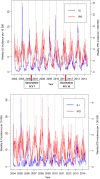Temporal cross-correlation between influenza-like illnesses and invasive pneumococcal disease in The Netherlands
- PMID: 27943624
- PMCID: PMC5304567
- DOI: 10.1111/irv.12442
Temporal cross-correlation between influenza-like illnesses and invasive pneumococcal disease in The Netherlands
Abstract
Background: While the burden of community-acquired pneumonia and invasive pneumococcal disease (IPD) is still considerable, there is little insight in the factors contributing to disease. Previous research on the lagged relationship between respiratory viruses and pneumococcal disease incidence is inconclusive, and studies correcting for temporal autocorrelation are lacking.
Objectives: To investigate the temporal relation between influenza-like illnesses (ILI) and IPD, correcting for temporal autocorrelation.
Methods: Weekly counts of ILI were obtained from the Sentinel Practices of NIVEL Primary Care Database. IPD data were collected from the Dutch laboratory-based surveillance system for bacterial meningitis from 2004 to 2014. We analysed the correlation between time series, pre-whitening the dependent time series with the best-fit seasonal autoregressive integrated moving average (SARIMA) model to the independent time series. We performed cross-correlations between ILI and IPD incidences, and the (pre-whitened) residuals, in the overall population and in the elderly.
Results: We found significant cross-correlations between ILI and IPD incidences peaking at lags -3 overall and at 1 week in the 65+ population. However, after pre-whitening, no cross-correlations were apparent in either population group.
Conclusion: Our study suggests that ILI occurrence does not seem to be the major driver of IPD incidence in The Netherlands.
Keywords: SARIMA; cross-correlation; filtering; influenza; pneumococci; pre-whitening; respiratory tract infections.
© 2016 The Authors. Influenza and Other Respiratory Viruses Published by John Wiley & Sons Ltd.
Figures




Similar articles
-
Estimating age-stratified influenza-associated invasive pneumococcal disease in England: A time-series model based on population surveillance data.PLoS Med. 2019 Jun 27;16(6):e1002829. doi: 10.1371/journal.pmed.1002829. eCollection 2019 Jun. PLoS Med. 2019. PMID: 31246954 Free PMC article.
-
Invasive pneumococcal disease among children in rural Bangladesh: results from a population-based surveillance.Clin Infect Dis. 2009 Mar 1;48 Suppl 2:S103-13. doi: 10.1086/596543. Clin Infect Dis. 2009. PMID: 19191605
-
Impact of pneumococcal conjugate vaccine and the severity of winter influenza-like illnesses on invasive pneumococcal infections in children and adults.Pediatr Infect Dis J. 2005 Jan;24(1):10-6. doi: 10.1097/01.inf.0000148930.41928.0d. Pediatr Infect Dis J. 2005. PMID: 15665704
-
Respiratory viruses, such as 2009 H1N1 influenza virus, could trigger temporal trends in serotypes causing pneumococcal disease.Clin Microbiol Infect. 2014 Dec;20(12):O1088-90. doi: 10.1111/1469-0691.12744. Epub 2014 Aug 13. Clin Microbiol Infect. 2014. PMID: 24977322
-
Epidemiology of invasive pneumococcal disease in the Arabian Peninsula and Egypt.Int J Antimicrob Agents. 2009 May;33(5):410.e1-9. doi: 10.1016/j.ijantimicag.2008.08.012. Epub 2008 Oct 30. Int J Antimicrob Agents. 2009. PMID: 18976887 Review.
Cited by
-
Seasonal Activity of Influenza in Iran: Application of Influenza-like Illness Data from Sentinel Sites of Healthcare Centers during 2010 to 2015.J Epidemiol Glob Health. 2018 Dec;8(1-2):29-33. doi: 10.2991/j.jegh.2018.08.100. J Epidemiol Glob Health. 2018. PMID: 30859784 Free PMC article.
-
Aberration detection in influenza trends in Iran by using cumulative sum chart and period regression.J Taibah Univ Med Sci. 2020 Oct 16;15(6):529-535. doi: 10.1016/j.jtumed.2020.09.002. eCollection 2020 Dec. J Taibah Univ Med Sci. 2020. PMID: 33318746 Free PMC article.
-
Influenza interaction with cocirculating pathogens and its impact on surveillance, pathogenesis, and epidemic profile: A key role for mathematical modelling.PLoS Pathog. 2018 Feb 15;14(2):e1006770. doi: 10.1371/journal.ppat.1006770. eCollection 2018 Feb. PLoS Pathog. 2018. PMID: 29447284 Free PMC article. Review.
-
The role of viral interference in shaping RSV epidemics following the 2009 H1N1 influenza pandemic.medRxiv [Preprint]. 2025 Feb 19:2024.02.25.24303336. doi: 10.1101/2024.02.25.24303336. medRxiv. 2025. Update in: Influenza Other Respir Viruses. 2025 Apr;19(4):e70111. doi: 10.1111/irv.70111. PMID: 38464193 Free PMC article. Updated. Preprint.
-
Estimating age-stratified influenza-associated invasive pneumococcal disease in England: A time-series model based on population surveillance data.PLoS Med. 2019 Jun 27;16(6):e1002829. doi: 10.1371/journal.pmed.1002829. eCollection 2019 Jun. PLoS Med. 2019. PMID: 31246954 Free PMC article.
References
-
- Bijkerk P, van Lier EA, McDonald S, et al. State of Infectious Diseases in the Netherlands, 2013. Bilthoven: 2014.
-
- Altizer S, Dobson A, Hosseini P, Hudson P, Pascual M, Rohani P. Seasonality and the dynamics of infectious diseases. Ecol Lett. 2006;9:467–484. - PubMed
-
- Fisman DN. Seasonality of infectious diseases. Annu Rev Public Health. 2007;28:127–143. - PubMed
-
- Kim PE, Musher DM, Glezen WP, Rodriguez‐Barradas MC, Nahm WK, Wright CE. Association of invasive pneumococcal disease with season, atmospheric conditions, air pollution, and the isolation of respiratory viruses. Clin Infect Dis. 1996;22:100–106. - PubMed
MeSH terms
LinkOut - more resources
Full Text Sources
Other Literature Sources
Medical

